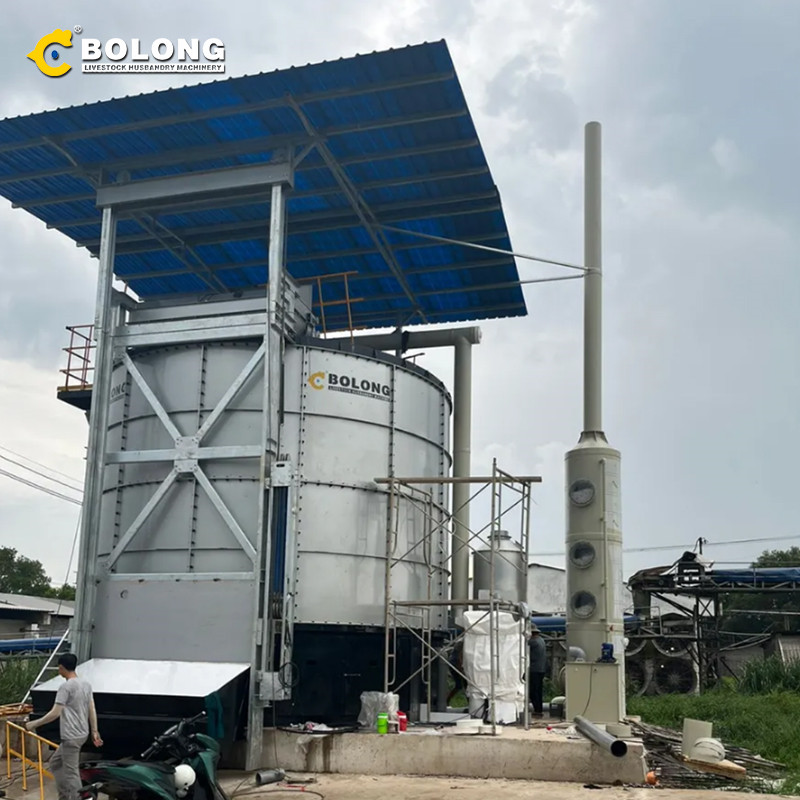High-temperature aerobic composting machines are equipment that decompose organic matter through high-temperature microorganisms. They treat a variety of organic wastes in an efficient, environmentally friendly and resource-based manner and are widely used in the fields of industry, aquaculture, planting and domestic waste treatment. Their core advantage is that they can quickly decompose waste and convert it into resource-based products, reducing environmental pollution and waste accumulation pressure. The following is a detailed analysis of the classification and uses of applicable materials for high-temperature aerobic composting machines from different fields.
Industrial production activities generate a large amount of organic waste. The treatment and resource utilization of these wastes are important application areas for high-temperature aerobic composting machines.
Byproducts generated by the food processing industry, such as brewing grains, tofu residues, fruit and vegetable processing residues, and discarded edible oil residues, are rich in organic matter and nutrients and are high-quality raw materials for high-temperature aerobic fermentation. After treatment, these wastes can be converted into organic fertilizers or feed additives to meet the needs of agricultural production or animal husbandry.
Pharmaceutical industry byproducts such as plant and Chinese medicine residues have high organic matter content, but are usually difficult to decompose naturally. Through high-temperature aerobic fermentation, they can be quickly converted into organic matrix and used to prepare soil conditioners and improve soil structure.
Pulp sludge and sludge from organic wastewater treatment produced by the paper industry are also suitable materials for high-temperature aerobic fermentation. After fermentation, these wastes can be made into compost for greening projects or agricultural planting.
Byproducts produced during agricultural processing, such as sugarcane bagasse, corn cobs, and cottonseed hulls, can not only solve the problem of waste accumulation through fermentation treatment, but also produce high-quality organic fertilizers for increasing agricultural production and income.

Animal husbandry production activities produce a large amount of animal manure and other organic waste, which puts great pressure on the environment. High-temperature aerobic composting machines can effectively treat these wastes and turn them into treasures.
Pig manure, cow manure, chicken manure, duck manure, etc. are common aquaculture wastes. These manures are rich in nitrogen, phosphorus, and potassium, but direct discharge without treatment will cause environmental pollution. Using high-temperature aerobic fermentation technology, pathogens and parasite eggs in manure can be killed by high temperature, and the fermentation products can be directly used in agricultural production as organic fertilizer.
Fish and shrimp manure and feed residues produced in aquaculture will affect water quality and ecological balance if not cleaned up in time. High-temperature aerobic fermentation can quickly decompose these wastes and convert them into ecological improvers or agricultural organic fertilizers for aquaculture farms.
Sawdust, rice husks and other litter used in farms form waste with high organic content after mixing with manure. These wastes can be fermented to form high-quality compost, which can be used in agriculture and forestry.

Organic waste generated by the planting industry includes crop straw, horticultural waste, and fruit and vegetable residues. These wastes are abundant in resources, but direct disposal without treatment will cause waste and pollution.
Crop straws such as rice straw, wheat straw, and corn straw are large in production and widely distributed, and are typical high-fiber organic wastes. Through high-temperature aerobic fermentation technology, these straws can be converted into organic fertilizer or compost to improve soil fertility and structure.
Waste such as pruned branches, dead grass, and leaves generated in landscaping and home gardening are also suitable for high-temperature aerobic fermentation. After treatment, these wastes can be used to make compost or horticultural substrates to increase soil permeability and water retention.
The large amount of fruit and vegetable residues generated in vegetable markets and food processing companies, including rotten fruits and vegetable leaves, are ideal materials for high-temperature aerobic fermentation. After fermentation, it can generate highly efficient organic fertilizer, which can be used in agricultural planting to improve the yield and quality of fruits and vegetables.
The mushroom planting substrate will be discarded after the planting cycle, but it still retains a certain amount of organic matter and nutrients. These substrates can be fermented to make soil-improving substrates or compost.

With the acceleration of urbanization, the proportion of organic components in domestic waste has increased year by year. High-temperature aerobic fermentation plays an important role in waste sorting, reduction and resource utilization.
The large amount of kitchen waste (such as leftovers, fruit peels and vegetable leaves) generated by households and the catering industry is the main source of organic waste. This type of waste can be quickly decomposed and converted into organic fertilizer in a high-temperature aerobic composting machine, which not only avoids odor pollution but also reduces landfill volume.
Waste paper, waste cotton cloth, tea dregs and coffee dregs generated in residents’ daily lives can also be used as fermentation raw materials. After high-temperature aerobic fermentation, these wastes can be used as resources to reduce negative impacts on the environment.
Grass clippings, dead branches, fallen leaves, etc. produced during pruning in residential and household greening can easily breed pests if not handled in time. Using a high-temperature aerobic composting machine, these wastes can be converted into organic-rich compost for greening backfill or soil improvement.
With the advantages of high treatment efficiency, high resource utilization and strong ecological and environmental protection, high-temperature aerobic composting machine has become one of the mainstream technologies for organic waste treatment. Whether it is industrial by-products, farming manure, planting waste, or food waste and garden waste from domestic waste, etc., they can all be used as applicable materials. High-temperature aerobic composting machines convert these wastes into organic fertilizers or soil-improvement products, which not only solves the problem of waste treatment, but also provides important support for the development of circular economy. This technology will further promote sustainable development in the future for the benefit of agriculture, industry and urban ecosystems.